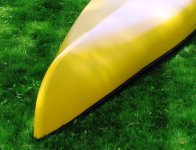I've got a Royalex canoe that has some wear on the underside of both the bow and stern, and could probably use skid plates. In the few years that I've had it, I just keep using gorilla tape on it to prevent further abrasion and for UV protection.
It's not a good or expensive canoe, and I will probably sell it this summer, but I figured it would be easier to sell with nice new skid plates, rather than duct tape. I suppose I could just touch up the spots with paint, but that might look just as bad as the duct tape. Plus, I've never done skid plates before, and I thought it might be good to practice on cheaper boat.
Kevlar kits seems to be ubiquitous, but they are expensive, thick, and heavy. I've read some favorable comments here about using Dynel. I also found a website for a product called KeelEazy which seems to be something like expensive duct tape applied with a heat gun.
I don't want to spend much money on this, but I'd like to get some practice doing something useful. Is Dynel my best bet? What type of epoxy do I need for a Royalex hull?
It's not a good or expensive canoe, and I will probably sell it this summer, but I figured it would be easier to sell with nice new skid plates, rather than duct tape. I suppose I could just touch up the spots with paint, but that might look just as bad as the duct tape. Plus, I've never done skid plates before, and I thought it might be good to practice on cheaper boat.
Kevlar kits seems to be ubiquitous, but they are expensive, thick, and heavy. I've read some favorable comments here about using Dynel. I also found a website for a product called KeelEazy which seems to be something like expensive duct tape applied with a heat gun.
I don't want to spend much money on this, but I'd like to get some practice doing something useful. Is Dynel my best bet? What type of epoxy do I need for a Royalex hull?

